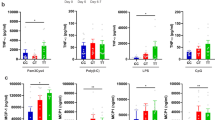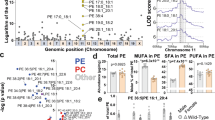Abstract
Fatty acid translocase (FAT)/CD36 has been associated with diverse normal and pathologic processes. These include scavenger receptor functions (uptake of apoptotic cells and modified lipid), lipid metabolism and fatty acid transport, adhesion, angiogenesis, modulation of inflammation, transforming growth factor-β activation, atherosclerosis, diabetes and cardiomyopathy. Although CD36 was identified more than 25 years ago, it is only with the advent of recent genetic technology that in vivo evidence has emerged for its physiologic and pathologic relevance. As these in vivo studies are expanded, we will gain further insight into the mechanism(s) by which CD36 transmits a cellular signal, and this will allow the design of specific therapeutics that impact on a particular function of CD36.
Similar content being viewed by others
References
Hamilton JA, Johnson RA, Corkey B: Fatty acid transport: The diffusion mechanism in model and biological membranes. J Mol Neurosci 16: 99–108; discussion 151-157, 2001
Hamilton JA, Kamp F: How are free fatty acids transported in membranes? Is it by proteins or by free diffusion through the lipids? Diabetes 48: 2255–2269, 1999
Hamilton JA: Transport of fatty acids across membranes by the diffusion mechanism. Prostagland Leukot Essent Fatty Acids 60: 291–297, 1999
Hamilton JA: Fatty acid transport: Difficult or easy? J Lipid Res 39: 467–481, 1998
Zakim D: Fatty acids enter cells by simple diffusion. Proc Soc Exp Biol Med 212: 5–14, 1996
Abumrad NA, Park JH, Park CR: Permeation of long-chain fatty acid into adipocytes. Kinetics, specificity, and evidence for involvement of a membrane protein. J Biol Chem 259: 8945–8953, 1984
Abumrad NA, Perkins RC, Park JH: Mechanism of long chain fatty acid permeation in the isolated adipocyte. J Biol Chem 256: 9183–9191, 1981
Harmon CM, Abumrad NA: Binding of sulfosuccinimidyl fatty acids to adipocyte membrane proteins: Isolation and amino-terminal sequence of an 88-kD protein implicated in transport of long-chain fatty acids. J Membr Biol 133: 43–49, 1993
Abumrad NA, el-Maghrabi MR, Amri EZ: Cloning of a rat adipocyte membrane protein implicated in binding or transport of long-chain fatty acids that is induced during preadipocyte differentiation. Homology with human CD36. J Biol Chem 268: 17665–17668, 1993
Stahl A, Gimeno RE, Tartaglia LA: Fatty acid transport proteins: A current view of a growing family. Trends Endocrinol Metab 12: 266–273, 2001
Abumrad N, Coburn C, Ibrahimi A: Membrane proteins implicated in long-chain fatty acid uptake by mammalian cells: CD36, FATP and FABPm. Biochim Biophys Acta 1441: 4–13, 1999
Abumrad NA, el-Maghrabi MR, Amri EZ: Cloning of a rat adipocyte membrane protein implicated in binding or transport of long-chain fatty acids that is induced during preadipocyte differentiation. Homology with human CD36. J Biol Chem 268: 17665–17668, 1993
Ibrahimi A, Sfeir Z, Magharaie H: Expression of the CD36 homolog (FAT) in fibroblast cells: Effects on fatty acid transport. Proc Natl Acad Sci USA 93: 2646–2651, 1996
Ibrahimi A, Bonen A, Blinn WD: Muscle-specific overexpression of FAT/CD36 enhances fatty acid oxidation by contracting muscle, reduces plasma triglycerides and fatty acids, and increases plasma glucose and insulin. J Biol Chem 274: 26761–26766, 1999
Van Nieuwenhoven FA, Verstijnen CP, Abumrad NA: Putative membrane fatty acid translocase and cytoplasmic fatty acid-binding protein are co-expressed in rat heart and skeletal muscles. Biochem Biophys Res Commun 207: 747–752, 1995
Watanabe K, Ohta Y, Toba K: Myocardial CD36 expression and fatty acid accumulation in patients with type I and II CD36 deficiency. Ann Nucl Med 12: 261–266, 1998
Bonen A, Luiken JJ, Liu S: Palmitate transport and fatty acid transporters in red and white muscles. Am J Physiol 275: E471–478, 1998
Bonen A, Dyck DJ, Ibrahimi A: Muscle contractile activity increases fatty acid metabolism and transport and FAT/CD36. Am J Physiol 276: E642–649, 1999
Coburn CT, Knapp FF Jr, Febbraio M: Defective uptake and utilization of long chain fatty acids in muscle and adipose tissues of CD36 knockout mice. J Biol Chem 275: 32523–32529, 2000
Fukuchi K, Nozaki S, Yoshizumi T: Enhanced myocardial glucose use in patients with a deficiency in long-chain fatty acid transport (CD36 deficiency). J Nucl Med 40: 239–243, 1999
Hajri T, Ibrahimi A, Coburn CT: Defective fatty acid uptake in the spontaneously hypertensive rat is a primary determinant of altered glucose metabolism, hyperinsulinemia and myocardial hypertrophy. J Biol Chem 25: 25, 2001
Nozaki S, Tanaka T, Yamashita S: CD36 mediates long-chain fatty acid transport in human myocardium: Complete myocardial accumulation defect of radiolabeled long-chain fatty acid analog in subjects with CD36 deficiency. Mol Cell Biochem 192: 129–135, 1999
Pravenec M, Landa V, Zidek V: Transgenic rescue of defective Cd36 ameliorates insulin resistance in spontaneously hypertensive rats. Nat Genet 27: 156–158, 2001
Collison M, Glazier AM, Graham D: Cd36 and molecular mechanisms of insulin resistance in the stroke-prone spontaneously hypertensive rat. Diabetes 49: 2222–2226, 2000
Febbraio M, Abumrad NA, Hajjar DP: A null mutation in murine CD36 reveals an important role in fatty acid and lipoprotein metabolism. J Biol Chem 274: 19055–19062, 1999
Watanabe K, Toba K, Ogawa Y: Hypertrophic cardiomyopathy with type I CD36 deficiency. Jpn Circ J 62: 541–542, 1998
Tanaka T, Sohmiya K, Kawamura K: Is CD36 deficiency an etiology of hereditary hypertrophic cardiomyopathy? J Mol Cell Cardiol 29: 121–127, 1997
Watanabe K, Ohta Y, Toba K: Myocardial CD36 expression and fatty acid accumulation in patients with type I and II CD36 deficiency. Ann Nucl Med 12: 261–266, 1998
Gotoda T, Iizuka Y, Yamada N: Complex connection between CD36 and atherosclerosis, lipid metabolism, and insulin resistance syndromes. Curr Atheroscler Rep 2: 453–454, 2000
Miyaoka K, Kuwasako T, Hirano K: CD36 deficiency associated with insulin resistance. Lancet 357: 686–687, 2001
Yanai H, Chiba H, Morimoto M: Type I CD36 deficiency in humans is not associated with insulin resistance syndrome. Thromb Haemost 83: 786., 2000
Gruarin P, Thorne RF, Dorahy DJ: CD36 is a ditopic glycoprotein with the N-terminal domain implicated in intracellular transport. Biochem Biophys Res Commun 275: 446–454, 2000
Oquendo P, Hundt E, Lawler J: CD36 directly mediates cytoadherence of Plasmodium falciparum parasitized erythrocytes. Cell 58: 95–101, 1989
Tao N, Wagner SJ, Lublin DM: CD36 is palmitoylated on both Nand C-terminal cytoplasmic tails. J Biol Chem 271: 22315–22320, 1996
Greenwalt DE, Lipsky RH, Ockenhouse CF: Membrane glycoprotein CD36: A review of its roles in adherence, signal transduction, and transfusion medicine. Blood 80: 1105–1115, 1992
Greenwalt DE, Mather IH: Characterization of an apically derived epithelial membrane glycoprotein from bovine milk, which is expressed in capillary endothelia in diverse tissues. J Cell Biol 100: 397–408, 1985
Swerlick RA, Lee KH, Wick TM: Human dermal microvascular endothelial but not human umbilical vein endothelial cells express CD36 in vivo and in vitro. J Immunol 148: 78–83, 1992
Ryeom SW, Sparrow JR, Silverstein RL: CD36 participates in the phagocytosis of rod outer segments by retinal pigment epithelium. J Cell Sci 109: 387–395, 1996
Endemann G, Stanton LW, Madden KS, et al.: CD36 is a receptor for oxidized low density lipoprotein. J Biol Chem 268: 11811–11816, 1993
Ryeom SW, Silverstein RL, Scotto A: Binding of anionic phospholipids to retinal pigment epithelium may be mediated by the scavenger receptor CD36. J Biol Chem 271: 20536–20539, 1996
Silverstein RL, Asch AS, Nachman RL: Glycoprotein IV mediates thrombospondin-dependent platelet-monocyte and platelet-U937 cell adhesion. J Clin Invest 84: 546–552, 1989
Lisanti MP, Scherer PE, Vidugiriene J: Characterization of caveolin-rich membrane domains isolated from an endothelial-rich source: Implications for human disease. J Cell Biol 126: 111–126, 19942
Dorahy DJ, Lincz LF, Meldrum CJ: Biochemical isolation of a membrane microdomain from resting platelets highly enriched in the plasma membrane glycoprotein CD36. Biochem J 319: 67–72, 1996
Lee H, Woodman SE, Engelman JA: Palmitoylation of caveolin-1 at a single site (Cys-156) controls its coupling to the c-Src tyrosine kinase. J Biol Chem 12: 12, 2001
Savill J, Hogg N, Ren Y: Thrombospondin cooperates with CD36 and the vitronectin receptor in macrophage recognition of neutrophils undergoing apoptosis. J Clin Invest 90: 1513–1522, 1992
Dawson DW, Pearce SF, Zhong R: CD36 mediates the in vitro inhibitory effects of thrombospondin-1 on endothelial cells. J Cell Biol 138: 707–717, 1997
Jimenez B, Volpert OV, Crawford SE: Signals leading to apoptosisdependent inhibition of neovascularization by thrombospondin-1. Nat Med 6: 41–48, 2000
Sfeir Z, Ibrahimi A, Amri E: Regulation of FAT/CD36 gene expression: Further evidence in support of a role of the protein in fatty acid binding/transport. Prostaglandins Leukot Essent Fatty Acids 57: 17–21, 1997
Luiken JJ, van Nieuwenhoven FA, America G: Uptake and metabolism of palmitate by isolated cardiac myocytes from adult rats: Involvement of sarcolemmal proteins. J Lipid Res 38: 745–758, 1997
Luiken JJ, Willems J, van der Vusse GJ: Electrostimulation enhances FAT/CD36-mediated long-chain fatty acid uptake by isolated rat cardiac myocytes. Am J Physiol Endocrinol Metab 281: E704–712, 2001
Binas B, Danneberg H, McWhir J: Requirement for the heart-type fatty acid binding protein in cardiac fatty acid utilization. Faseb J 13: 805–812, 1999
Glatz JF, van Nieuwenhoven FA, Luiken JJ: Role of membrane-associated and cytoplasmic fatty acid-binding proteins in cellular fatty acid metabolism. Prostaglandins Leukot Essent Fatty Acids 57: 373–378, 1997
Aitman TJ, Glazier AM, Wallace CA: Identification of Cd36 (Fat) as an insulin-resistance gene causing defective fatty acid and glucose metabolism in hypertensive rats. Nat Genet 21: 76–83, 1999
Pravenec M, Landa V, Zidek V: Transgenic rescue of defective Cd36 ameliorates insulin resistance in spontaneously hypertensive rats. Nat Genet 27: 156–158, 2001
Knapp FF, Jr., Kropp J, Franken PR: Pharmacokinetics of radioiodinated fatty acid myocardial imaging agents in animal models and human studies. Quart J Nucl Med 40: 252–269, 1996
Li AC, Brown KK, Silvestre MJ: Peroxisome proliferator-activated receptor gamma ligands inhibit development of atherosclerosis in LDL receptor-deficient mice. J Clin Invest 106: 523–531, 2000
Author information
Authors and Affiliations
Rights and permissions
About this article
Cite this article
Febbraio, M., Guy, E., Coburn, C. et al. The impact of overexpression and deficiency of fatty acid translocase (FAT)/CD36. Mol Cell Biochem 239, 193–197 (2002). https://doi.org/10.1023/A:1020515210972
Issue Date:
DOI: https://doi.org/10.1023/A:1020515210972




